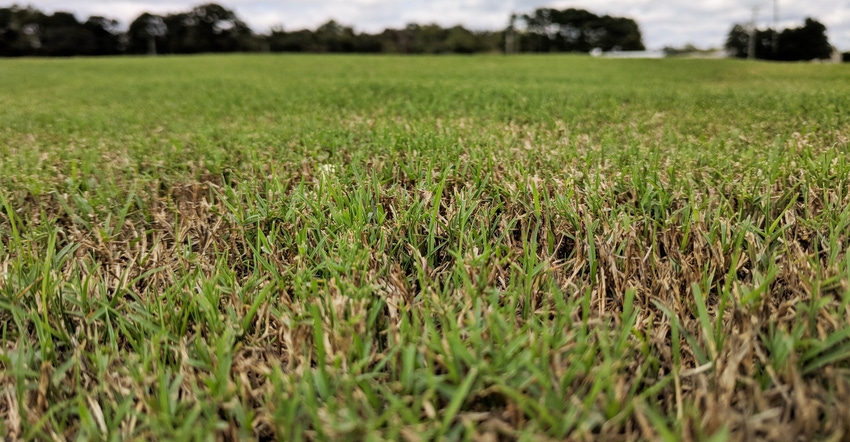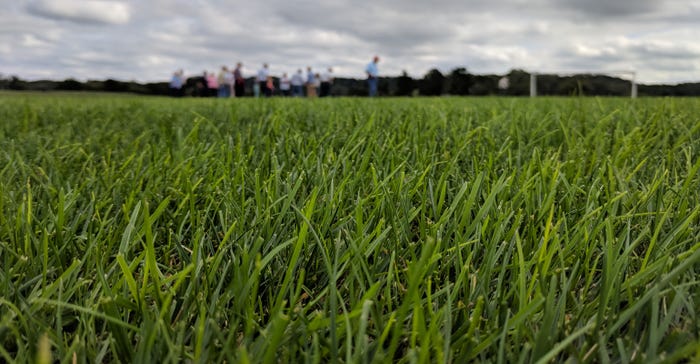Buckeye Beef Brief: The idea that the lower you mow, the more grass you get is misguided.
July 25, 2019

By Christine Gelley
All of us have a bad habit here or there that we have developed over time. Bad habits are often questionable actions that can cause some stress, but rarely have direct negative consequences immediately afterward. Usually, the negative consequences are compounded over time into large problems, and that is when we realize we have gone wrong.
A bad habit that many grass managers have in lawn and hay systems is cutting it too close. By “it,” I mean the grass. There are some misconceptions about what the best height is to cut grass. It can also be confusing, because ideal cutting height varies with the type of grass. The common denominator is that many homeowners and haymakers are cutting the grass too low and inducing stress responses on the plants that cause us issues down the road.
Type of grass determines mowing height
Depending on the grass species, variety and environmental conditions, mowing height and frequency can vary greatly. The turf grasses that grow on a professional golf course are drastically different from the turf on a children’s soccer field. The most common plants in tallgrass warm-season pastures or shortgrass cool-season pastures are drastically different. In all cases, we want to be aware of where new growth occurs on the grass stem, and how deep the root system goes.
The region on the stem where new growth emerges is called the apical meristem. Grasses will grow back best after a cutting if the apical meristem is not damaged. If the apical meristem is mowed off, the plant must produce a new shoot, called a tiller, to regrow. This draws additional nutrients from the root system. This is true in lawns, hay and grazed pasture.
If grasses are regularly mowed or grazed too short, root energy reserves can be easily depleted, causing nutrient deficiencies and low stand persistence. Low persistence makes your grass stand look patchy.
Weeds soon fill in those patches. Often people get into a cycle of cutting it too close and then fertilizing, irrigating, and/or applying herbicides to try to remedy the damage.
In those cases, the problem is not soil fertility or water in the soil or that new weeds are suddenly invading. More likely, it is reduced ability of the plant to draw the nutrients and water from the soil. Together, regular soil tests and stand evaluations can help you troubleshoot problems that arise.

HEALTHY MOW: This grassland was mowed at the correct height and is thriving.

Remove one-third of leaf
A general rule for lawns is that when you mow, you should only be removing one-third of the total leaf area. That means if the grass is 6 inches tall, mowing it to 4 inches, or from 3 inches to 2 inches, depending on your grass. In hay production in cool-season pastures (examples are orchardgrass, tall fescue, etc.), mow or graze before seed heads develop, down to 3 to 5 inches. In warm-season pastures (examples are switchgrass, sorghum-sudangrass, etc.) mow or graze down to 8 to 10 inches if you expect regrowth.
Don’t ‘scalp’ grass
The idea that the lower you mow, the more grass you get is misguided. The lower you go, the more stems you remove than leaves, and the more soil material and rocks you kick up as you mow. That is not good for your grass, soil or equipment. Mowing or grazing grass too low is called “scalping.” Don’t scalp anything you expect to live afterward.
Setting your mower deck and cutter bar high enough for the grass you are managing can be a challenge for some machinery. If you cannot adjust it as high as you need, consult an implement dealer to investigate if additional components can be installed to raise the height.
Collars for cutter bar lift cylinders or high-clearance skid shoes may do the job. Sometimes adjusting the cutter bar angle can increase cutting height. Getting this situated will take some trial and error. Be cautious as you mow, and watch for side-drift or improper trailing of the implement. When making adjustments with collars or shoes, always power off the machine, park on a level surface and engage safety locks.
Over time, mowing at a higher height in the canopy will improve the health of your grass stand, reduce the presence of weeds and improve the quality of your soil, giving you thicker stands of desirable grasses. To learn more about mowing heights for your lawn or hay, feel free to contact your county Extension office, or the author through email at [email protected].
Gelley is an Ohio State University Extension agriculture and natural resources educator from Noble County, Ohio.
You May Also Like



